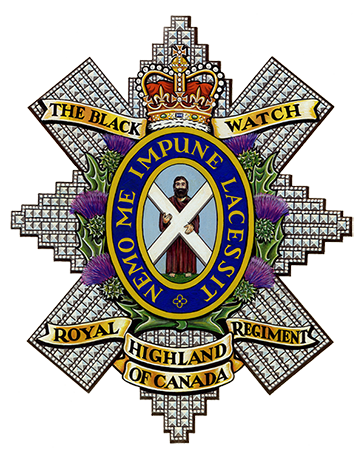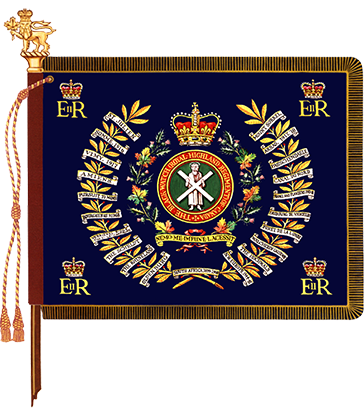The Black Watch (Royal Highland Regiment) of Canada
The official lineage of The Black Watch (Royal Highland Regiment) of Canada infantry regiment.

Colonel-in-Chief: His Majesty King Charles III, King of Canada
Badge
Description
Azure the figure of St. Andrew proper standing on a mount Vert holding his cross Argent all within an annulus Azure fimbriated and inscribed "NEMO ME IMPUNE LACESSIT" in letters Or, ensigned by the Royal crown and environed by a wreath of thistles proper all between a scroll on either side of the Crown inscribed THE BLACK WATCH and two scrolls Or in base inscribed ROYAL HIGHLAND REGIMENT and OF CANADA in letters sable, the whole set on the diamond-cut star of the Order of the Thistle Argent.
Symbolism
The Crown represents service to the Sovereign. The badge of the regiment is styled on that of their former British allied regiment The Black Watch (Royal Highland Regiment) - now, through amalgamation, The Royal Regiment of Scotland - whose badge, in turn, was based on that of the Most Ancient and Most Noble Order of the Thistle, the highest order of chivalry in Scotland. The diamond-cut star, the thistles (the national flower of Scotland) and the representation of St. Andrew (the patron saint of the Order and of Scotland) and the cross appear on the Order's badge. The scrolls bearing the words "THE BLACK WATCH", "ROYAL HIGHLAND REGIMENT" and "OF CANADA" are a form of the regimental title and "NEMO ME IMPUNE LACESSIT" is the motto of the regiment and the Order of the Thistle.
Motto
NEMO ME IMPUNE LACESSIT (No one shall touch me with impunity)
Quick March
"The Highland Laddie"
Slow March
"The Red Hackle"
Alliance
British Army
The Royal Regiment of Scotland
Regimental colour

Camp flag

Battle honours
The War of 1812
DEFENCE OF CANADA – 1812-1815 – DÉFENSE DU CANADA; CHÂTEAUGUAY
South African War
SOUTH AFRICA, 1899-1900.
The First World War
YPRES, 1915, '17; Gravenstafel; St. Julien; FESTUBERT, 1915; MOUNT SORREL; SOMME, 1916; Pozières; Flers-Courcelette; Thiepval; Ancre Heights; Ancre, 1916; ARRAS, 1917, '18; Vimy, 1917; Arleux; Scarpe, 1917, '18; HILL 70; Passchendaele; AMIENS; Drocourt-Quéant; HINDENBURG LINE; Canal du Nord; PURSUIT TO MONS; FRANCE AND FLANDERS, 1915-18.
The Second World War
BOURGUÉBUS RIDGE; Faubourg de Vaucelles; Verrières Ridge-Tilly-la-Campagne; FALAISE; Clair Tizon; Forêt de la Londe; Dunkirk, 1944; Antwerp-Turnhout Canal; THE SCHELDT; Woensdrecht; South Beveland; Walcheren Causeway; THE RHINELAND; The Hochwald; Xanten; THE RHINE; Groningen; Oldenburg; NORTH-WEST EUROPE, 1944-1945.
South-West Asia
AFGHANISTAN
Lineage
This Reserve Force regiment originated on 31 January 1862 and incorporates the following regiment and battalions.
The Black Watch (Royal Highland Regiment) of Canada originated in Montreal, Quebec on 31 January 1862, when the '5th Battalion Volunteer Militia Rifles, Canada' was authorized to be formed.Footnote 1 It was redesignated: '5th Battalion, "The Royal Light Infantry of Montreal"' on 7 November 1862;Footnote 2 '5th Battalion, "Royal Fusiliers"' on 19 November 1875;Footnote 3 '5th Battalion, "Royal Scots Fusiliers"' on 27 February 1880;Footnote 4 '5th Battalion, "Royal Scots of Canada"' on 29 February 1884;Footnote 5 '5th Regiment "Royal Scots of Canada"' on 8 May 1900;Footnote 6 '5th Regiment "Royal Scots of Canada, Highlanders"' on 2 May 1904;Footnote 7 '5th Regiment "Royal Highlanders of Canada"' on 1 October 1906;Footnote 8 'The Royal Highlanders of Canada' on 29 March 1920;Footnote 9 'The Black Watch (Royal Highlanders) of Canada' on 1 January 1930;Footnote 10 and 'The Black Watch (Royal Highland Regiment) of Canada' on 1 July 1935.Footnote 11 On 16 October 1953, it was amalgamated with the '1st Canadian Highland Battalion' and the '2nd Canadian Highland Battalion' (see below), retaining the same designation.Footnote 12
Notes:
The 5th Battalion, "The Royal Light Infantry of Canada" was disbanded for the purpose of reorganization on 2 June 1871 (MGO 14/71). It was reorganized on 12 April 1872 (MGO 18/71 and MGO 9/72). This change was administrative and does not affect the lineage of the regiment.
On 1 August 1906, the regiment was organized as a two battalion regiment with both the 1st Battalion and 2nd Battalion on the Non Permanent Active Militia Order of Battle (GO 125/06).
Upon redesignation as The Royal Highlanders of Canada on 12 March 1920 (see above), it was organized as a four battalion regiment with the 1st Battalion (13th Battalion, CEF) and 2nd Battalion (42nd Battalion, CEF) on the Non Permanent Active Militia order of battle, and the 3rd Battalion (73rd Battalion, CEF) and 4th Battalion (no CEF designation) on the Reserve order of battle. The reserve units were disbanded on 14 December 1936 (GO 3/37).
The Royal Highlanders of Canada were disbanded for the purpose of reorganization on 1 October 1920 and reorganized the same day (GO 232/20). This change was administrative and does not affect the lineage of the regiment.
On 1 September 1939, when the '1st Battalion, The Black Watch (Royal Highland Regiment) of Canada, CASF' was mobilized (see Operational History below) the Non Permanent Active Militia battalion still existed, even if only on paper. Thus, on 7 November 1940, the '1st Battalion' and the '2nd Battalion' were redesignated the '2nd (Reserve) Battalion' and the '3rd (Reserve) Battalion'. On 18 March 1942, when a second active service battalion was mobilized, they became the '3rd (Reserve) Battalion' and '4th (Reserve) Battalion', respectively (GO 273/40 and GO 42/41).
On 15 August 1943, when the 2nd Battalion of the Active Service Force was disbanded, the 4th (Reserve) Battalion was redesignated the '2nd (Reserve) Battalion' (GO 469/43).
On 30 November 1945, when the active service battalion was disbanded, the 3rd (Reserve) Battalion was redesignated the '1st Battalion' (GO 400/45 and GO 85/46). On 31 March 1946, the 2nd (Reserve) Battalion and the Regimental Headquarters (authorized 1 October 1920 (GO 161/20)) were disbanded and the 1st (Reserve) Battalion automatically relinquished its numerical designation (GO 113/46).
On 4 May 1951, the regiment mobilized two temporary Active Force companies designated "E" and "F" (CAO 110-2, Pt 'B', Supp Issue No. 245/51 and SD 1 Letter No. 4237, 5 May 1951). "E" Company was reduced to nil strength upon its personnel being incorporated into the '1st Canadian Highland Battalion' for service in Germany with the North Atlantic Treaty Organization (SD 1 Letter No. 4365, 12 November 1951). It was disbanded on 29 July 1953 (CAO 78-2, Pt 'B', Supp Issue No. 352/53). "F" Company was initially used as a reinforcement pool for "E" Company. On 15 May 1952, it was reduced to nil strength, upon its personnel being absorbed by the newly formed '2nd Canadian Highland Battalion' for service in Korea with the United Nations (SD 1 Letter No. 4452, 22 April 1952 and CAO 110-2, Pt 'B', Supp Issue No. 283/52). "F" Company was disbanded on 29 July 1953 (CAO 78-2, Pt 'B', Supp Issue No. 352/53).
On 16 October 1953, the Reserve Force unit was redesignated as the 3rd Battalion (CAO 76-3, Pt 'B', Supp Issue No. 358/53).
On 1 July 1970, when the 1st and 2nd Battalions were reduced to nil strength and transferred to the Supplementary Order of Battle, the Reserve Force battalion automatically relinquished its numerical designation (Message, CANFORCEHED DO 32, 011845Z APR 70, Document Collection 73/1223, Series 2, File 1050, Box 55).
The 1st Canadian Highland Battalion originated in Valcartier, Quebec on 4 May 1951, when the '1st Canadian Highland Battalion' was authorized to be formed in the Active Force.Footnote 13 On 16 October 1953, it was redesignated the '1st Battalion, The Black Watch (Royal Highland Regiment) of Canada', as above.
The 2nd Canadian Highland Battalion originated in Aldershot, Nova Scotia on 10 April 1952, when the '2nd Canadian Highland Battalion' was authorized to be formed in the Active Force.Footnote 14 On 16 October 1953, it was redesignated the '2nd Battalion, The Black Watch (Royal Highland Regiment) of Canada', as above.
Perpetuations
'5th Battalion, Select Embodied Militia', '13th', '42nd' and '73rd "Overseas" Battalion(s), CEF'
Headquarters Location
Montreal, Quebec
Operational history
The Fenian Raids
The 5th Battalion, "The Royal Light Infantry of Canada" was called out on active service on 8 March 1866. The battalion, which served on the South-eastern frontier, was removed from active service on 31 March 1866.Footnote 15
The battalion was called out on active service on 24 May 1870. It served on the South-eastern frontier and was removed from active service on 31 May 1870.Footnote 16
South African War
The regiment contributed volunteers for the Canadian Contingents, mainly to the '2nd (Special Service) Battalion, Royal Canadian Regiment of Infantry'.Footnote 17
The First World War
Details of the regiment were placed on active service on 6 August 1914 for local protective duty.Footnote 18
The 13th Battalion, which was authorized on 1 September 1914 as the '13th Battalion, CEF',Footnote 19 embarked for Great Britain on 26 September 1914.Footnote 20 It disembarked in France on 16 February 1915, where it fought as part of the 3rd Infantry Brigade, 1st Canadian Division in France and Flanders until the end of the war.Footnote 21 The battalion was disbanded on 15 September 1920.Footnote 22
The 42nd Battalion, which was authorized on 7 November 1914 as the '42nd Battalion, CEF',Footnote 23 embarked for Great Britain on 10 June 1915.Footnote 24 It disembarked in France on 9 October 1915, where it fought as part of the 7th Infantry Brigade, 3rd Canadian Division in France and Flanders until the end of the war.Footnote 25 The battalion was disbanded on 15 September 1920.Footnote 26
The 73rd Battalion, which was authorized on 10 July 1915 as the '73rd "Overseas" Battalion, CEF',Footnote 27 embarked for Great Britain on 31 March 1916.Footnote 28 It disembarked in France on 13 August 1916, where it fought as part of the 12th Infantry Brigade, 4th Canadian Division until 9 April 1917 when it was withdrawn from the line after Vimy and broken up to provide reinforcements.Footnote 29 The battalion was disbanded on 19 April 1917.Footnote 30
The Second World War
The 2nd Battalion was called out on service on 26 August 1939 and details of the battalion were placed on active service on 1 September 1939, under the designation '2nd Battalion, The Black Watch (Royal Highland Regiment) of Canada, CASF (Details), for local protection duties.Footnote 31 The details called out on active service were disbanded on 31 December 1940.Footnote 32
The regiment mobilized the '1st Battalion, The Black Watch (Royal Highland Regiment) of Canada, CASF' for active service on 1 September 1939.Footnote 33 This unit, which served in Newfoundland from 22 June to 11 August 1940, embarked for Great Britain on 25 August 1940.Footnote 34 On 6 July 1944, the battalion landed in France as part of the 5th Infantry Brigade, 2nd Canadian Infantry Division, and it continued to fight in North West Europe until the end of the war.Footnote 35 The overseas battalion was disbanded on 30 November 1945.Footnote 36
Note:
Three platoons took part on the raid on Dieppe on 19 August 1942.
The regiment subsequently mobilized the '2nd Battalion, The Black Watch (Royal Highland Regiment) of Canada, CASF' for active service on 18 March 1942.Footnote 37 This unit served in Canada in a home defence role as part of Atlantic Command.Footnote 38 The battalion was disbanded on 15 August 1943.Footnote 39
South-West Asia
From 2002 to 2014, the Black Watch of Canada reinforced various CAF units deployed to AfghanistanFootnote 40